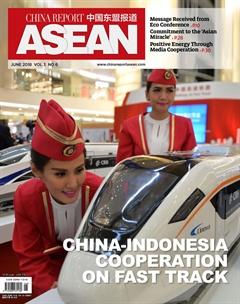A Place Like Home
China-Malaysia Qinzhou Industrial Park in Chinas Guangxi Zhuang Autonomous Region is the first industrial park run in cooperation between the Chinese government and the Malaysian government. It is also a demonstration project of China-ASEAN cooperation to further strengthen the strategic partnership and deepen economic and trade investment cooperation between the two governments after the establishment of the China-ASEAN Free Trade Area.
Since its inauguration on April 1, 2012, Qinzhou Industrial Park has progressed fast in infrastructure and services, which wouldnt have been possible without active cooperation and participation of China-Malaysia Qinzhou Industrial Park (Guangxi) Development Co., Ltd.
Mooi Mok Sang, chief financial officer of the partner company from Malaysia, spoke to our reporter about his years in the industrial park. “It has been a mixture of joy and sorrow,” he gestured. “Gradually, Ive fallen in love with it.”
Growth from Scratch
On January 6, 2014, China-Malaysia Qinzhou Industrial Park (Guangxi) Development Co., Ltd. was officially launched. It is a joint venture among China-Malaysia Qinzhou Industrial Park (Guangxi) Investment Services Company, Guangxi Beibu Gulf Port Affairs Group, Malaysias Rimbunan Hijau Group (RH Group) and S P Setia. Headquartered in the industrial park, the company is the sole developer and operator of the park.
“Were now primarily committed to the overall development and construction of the park,” says Mooi. “We are responsible for investment, construction, maintenance and operation of the parks basic infrastructure and supporting facilities such as water, gas, electricity, roads and greenery.”
On the development of the park, Mooi has a lot to say. “When we first arrived, it was a barren wasteland,” he reveals. “Its a lot better now. We have a hair salon, a commissary and a coffee shop, but no cinema, shopping mall or marketplace yet.”
“Also, we lack anywhere to relax after work or for young couples to go for a walk together,” he adds with a smile. “There is a lot more for us to do.”
Despite the arduous journey, Mooi has remained full of hope for the future of the industrial park. “Personally, I believe the parks development will accelerate significantly after 2025,” he says. “In the interim we have to be patient because construction and development of the park cannot be accomplished overnight.” He compares the parks development to cooking chicken soup in a casserole, which takes time to ensure the soup is delicious.
However, Mooi is quite confident about the future of Qinzhou Industrial Park. “The future is bright here,” he grins. “This is a cooperation project involving the governments of China and Malaysia. China has cooperated with two ASEAN countries, Malaysia and Singapore, to build industrial parks. This model of ‘Two Countries, Twin Parks has won the support from governments and enterprises on all sides. We are ready to promote Malaysias position as a major stop on the 21st Century Maritime Silk Road.”
Already a hub of the 21st Century Maritime Silk Road, Malaysia has enthusiastically participated in the China-proposed Belt and Road Initiative. The Federation of Chinese Associations Malaysia (FCAM) has set up the Belt and Road Center of Malaysia, issued a statement with several other national associations and chambers of commerce and organized a business dialogue and other activities. The gradual growth of Qinzhou Industrial Park from nothing is the result of efforts by pioneers like Mooi and mirrors the continuous development and gradual deepening of China-Malaysia relations.
Affinity with China
Mooi seems emotionally connected with China. “From the bottom of my heart, I love China like I love Malaysia,” he admits. “Qinzhou Industrial Park feels like home away from home as I work for the further development of both of my homes.”
On why he chose to work in Qinzhou, Mooi has much to say. Previously, he worked in various locations in Malaysia and China, so he is familiar with the working environment in China.
“In 2008, I started working in a water plant in Fujian Province for more than a year before returning to Malaysia,” Mooi reveals. “When I went back to Malaysia, I missed China. I came back and worked in an agricultural chemicals factory in Jiangsu Province before I was hired to do some other jobs. Guangxi is the fifth region in which I have worked. I like this place best because the climate is similar to Malaysia.”
Speaking of his experience at Qinzhou Industrial Park, Mooi illustrates, “When I first arrived, I was a little surprised because it was a wasteland—nothing like any of my previous working environments. As time passed, I started feeling differently because I personally witnessed and participated in every step of its development. Our efforts have paid off, and we now feel a bond with the park. Im very proud of the successful cooperation between our countries.”
Mooi believes that the cooperation model of “Two Countries, Twin Parks” is greatly significant. “Guangxi has provided opportunities for Malaysian entrepreneurs,” he explains. “They used to worry about doing business in China because of a lack of understanding of Chinas national conditions, economic policies and business partners. The intergovernmental cooperation model reassured them. Without worrying about any political risk, Malaysian investors also enjoy the great advantage of direct access to all kinds of information from the administrative committee of the industrial park.”
Overseas investors monitor the political, economic and natural risks in investment destinations, especially political ones. Mooi believes that the “Two Countries, Twin Parks” model has helped investors eliminate political risk and strengthen bilateral cooperation in investment.
“Everyone has their own unique experience and vision about life,” adds Mooi. His working environment and job responsibility at Qinzhou Industrial Park starkly contrast previous jobs. After adapting to the environment, Mooi became closely connected to the park. “I think of the park like my ‘child who is growing up with each passing day,” he smiles.

